#Fundamentals of creature design
Explore tagged Tumblr posts
Text

Finished design for the Eastern Serix, which I made using the Fundamentals Of Creature Design book. I really recommend picking it up if you want to really challenge yourself on really researching and having several passes at creating fictional creatures and really thinking about how and where it would live, feed, walk/swim/fly, breed, sleep. Really useful stuff to practice and full of great examples and references.
I wanted a tree dwelling hunter, so i tried to combine traits from a Fossa, Emerald Tree Boa, and a created gecko, I also threw in some inspiration from lemurs and frilled lizards.
The Eastern Serix is nocturnal and hunts mice and small birds, it uses its long, bristly tail to suspend its body from branches and releases when it wants to drop onto unsuspecting prey below. It then wraps its tail around them and the bristly fur stands on end and sticks into the prey, holding in place like thousands of tiny needles. It is then able to unhinge its jaw and swallow prey whole. The striped fur along its neck can be extended to form a frill to scare off predators.
#Fundamentals of creature design#creature design#creature creation#speculative zoology#creature concept#creature#speculative biology#speculative design#speculative art#speculative biology art#digital art#black and white art#procreate#animal design#animal design art#animal art#fossa#Tree python#lemur#frilled lizard#digital design#concept art
10 notes
·
View notes
Text
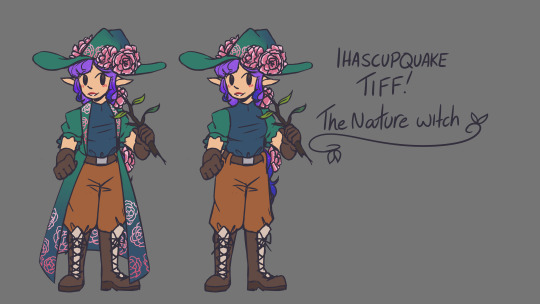
I would like to thank the Witch Craft SMP for gifting me a reason to draw Ihascupquake fanart in the year of our lord 2023
#rambles#my art#mcyt#witchcraft smp#wcsmp#ihascupquake#ihascupquake fanart#*points gun* ALL OF YOU APPRECIATE TIFFANY QUAKE THIS INSTANT ITS AN ORDER#THAT RIGHT THERE IS MY MINECRAFT MOM AND ON OF THE REASONS I DRAW TO THIS DAY I LOVE HER#anyways omg hiii blockmen art? from aj catzgam3rz? who'da thunk!#i love her outfit and ALL OF THE WITCHES OUTFITS??? THEY ALL LOOK SO COOL???#i wanna watch peoples intros and then draw more of them because it makes my brain go brrrr :)#oh also colours subject to change! but I enjoy this as like a starting point :D also the flowers are inspired by Peonies!#idk if I got close enough to call them peonies but thats what I was looking at!#also accidentally maybe implied a starborne!Tiff with this design? In my Heart of Hearts she's some sort of Fae creature but maybe both :0?#okay okay ranting over but i am serious if you are interested please consider ihascupquakes pov :D#she is probably one of the most fundamentally influential content creators I engaged with as a kid#and she is still so entertaining and sweet ;w;#I'm suddenly really worried that the ref I was using was too dark for the teal?? because the thumbnail looks brighter >:/?
349 notes
·
View notes
Text
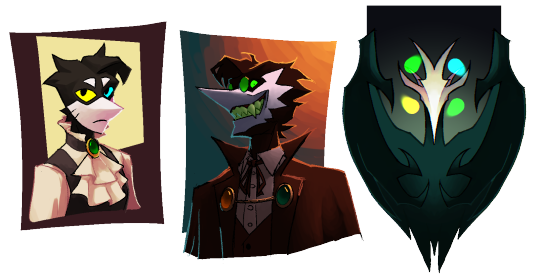
The three weirdos in my head!
#my art#dr. cline#mr. trubbaya#ethos#digital art#ocs#original character#creature#creature design#character design#dr. jekyll and mr. hyde#this is fundamentally a jekyll n hyde au with my ocs so thats why im tagging it as such#weirdfur
13 notes
·
View notes
Text

beast in my book
#this book is actually all about beasts and creatures. but this one specifically is The Beast#the book's called Fundamentals of Creature Design btw I've been rotating it in my brain for the past 15 hours
4 notes
·
View notes
Text
I agree with the idea that a lot of humans nowadays have a severe lack of curiosity about the world, but I think there has to be a solution other than shame.
I think about this every day because the fate of our world hangs on curiosity: either we will rediscover the importance and wonders of the soil and bugs and flowers and water and finally with the whole natural world, or this way will be forgotten.
People raised in the great wasteland of the suburbs and roads and buildings have never seen most of the plants and creatures that are supposed to fill every field and meadow. So many humans have never seen with their own eyes more than a scant few of the most common of hundreds of wildflowers that are supposed to surround them. Some live in biomes designated forest and have never witnessed truly mature trees. They do not know what the birds sound like. When they see an ordinary deer, they are awed and amazed by it or even afraid of it. They have never eaten any of the delicious wild fruits that grow in their homeland; all birds except starlings and robins and sparrows are so strange and beautiful that they stare in wonder. They confront insects like people on an alien planet encountering an unknown life form: What is this? Will it hurt me?
I cannot even describe the grief I feel on behalf of humans that grow up and live in the wasteland of pavement and lawn. That we are expected to live in these brutal environments, that we are expected to be content without the right or ability to live alongside living creatures, to walk among wildflowers, to hear birdsong, to feel the plush softness of moss, to see even common bees and butterflies—the fact that we live, work, and raise our children in poisonous wastes where nearly everything has been wiped out, and the simplest and most abundant of natural pleasures are rare privileges—it's cruel. It's a crime against the human spirit. It makes me so angry and sad.
When I started researching plants, I had no idea that I would end up expanding my mind so much that I would be virtually a different person within the year. Before I learned, I could not have imagined the diversity and beauty that exists in the world. My mind did not have the tools to come up with it.
I lived for over twenty years believing that there was only one species of firefly. I lived for over twenty years not knowing that the Southeastern US has native bamboo. I had never tasted the indescribable flavor of a pawpaw or seen the iridescent vibrance of a red-spotted purple butterfly. I had only seen a Pileated Woodpecker out the window of a car. I had never touched true topsoil, the soft, living blanket of rich, sweet-smelling earth full of mycelium, as springy and plush as a mattress. Just one year ago, I knew nothing!
Humans, as creatures, are insatiably curious and hunger for beauty. It is so cruel to deprive a human of relationship with their natural environment.
It is no wonder that we are all addicted to the internet—we have a crucial need that is unfulfilled. Compared with a forest, the world of lawns and buildings is so ridiculously flat and unstimulating. You would expect humans in such a place to feel constantly bored, restless, frustrated, and incurably sad.
I feel that lack of curiosity can be a chosen thing, but it is also a defense mechanism against a world that will feel like sandpaper on the senses of the curious.
But we need curiosity to fix this—we need the ability to notice the living things that have crept in at the edges of the wasteland and be infected and tormented by their beauty. We need to recognize the forest reaching into our cage in the form of tiny saplings. We need to discard the word "weed," not because it is derogatory because it is fundamentally incurious—it designates a plant as needing no identity outside of its unwantedness. We must learn their names. We must wonder what their names are.
15K notes
·
View notes
Note
I absolutely love your character concepts and how you re-design characters while keeping them fundamentally /them/, its so interesting! I was wondering if you would maybe be willing to draw Midna and Fi interacting in someway, maybe Midna questioning her companionship when this creature pops out of Link's sword- Bonus points for a bewildered Twilight who has never seen Fi before :D

there we go! XDDDD Twilight is so stunned! and Midna is not a fan of this new creature trying to steal her place!
712 notes
·
View notes
Text
Nintendo vs Pocket Pair is worse than you think
When Palworld came out, it took the gaming world by storm and became an instant hit with players who enjoy a mixture of creature collecting and survival base building. However, when a new game stirs up this much publicity, it catches both positive *and* negative attention.
There's no question about how similar Pals look to Pokemon, and there's much debate over the authenticity around Palworld's model designs. So much so, people were raising alarm to Nintendo to investigate Pocket Pair for IP infringement. Which Nintendo responded with a lukewarm, "We'll look into it."
After months of silence, Nintendo has now come forward with a lawsuit against Pocket Pair, but not for what we thought. The lawsuit is not about creature design, it's over *patent infringement.*
The patent in question is specifically over the mechanic of allowing the player to perform "an action of launching" to either "catch a field character or cause a fighting character to fight against a field character."
In simple words, the very act of throwing an item to capture a creature, or to summon a creature to fight another.
This mechanic is fundamental to nearly ALL creature collecting games.
Regardless of your personal feelings regarding Palworld vs Pokemon, this hopefully sounds wrong to you. This legal battle is little more than a billion dollar juggernaut swinging down their hammer onto an indie studio. It doesn't matter Pals *look* like pokemon. It DOES matter that they are demanding absolute control over creature collecting mechanics.
The patent in question does not even care if the item is sphere shaped like a pokeball. The item used for capture is irrelevant in this extremely broad patent.
Ultimately, Palworld is caught in this because of the massive attention it got, and this lawsuit is setting a deeply disturbing precedent. This lawsuit says, "If you look like a competitor to us, we'll sue you for daring to try."
And that's a danger to all creature collecting games, not just Palworld.
#look i love pokemon AND palworld but this is wrong#nintendo has always grossly abused their power and i cant stand it#nintendo#palworld#pokemon
301 notes
·
View notes
Text
That said, the D&D 3.5 Paladin was bad. It was badly designed, it had bad rules, and in conjunction with the other notoriously bad rule, alignment, it could cause havoc.
Now personally, I never had ANY problems with it in my tabletop games. I played paladins and loved it, and I loved it when other people played paladins, and it was great. But that's because, collectively as a group, we took ONE look at that terrible rule where the paladin's code of conduct prevents them from associating with Evil characters or "someone who consistently offends her moral code", and immediately went, "that's stupid, we ain't doing that, it would ruin the game".
We also didn't love the concept of alignment as a cosmic force, and didn't care for Usually Evil Goblins and Always Evil anything. And when a class's signature ability fully depends on whether creatures are capital E Evil, well that affects storytelling, doesn't it? But we all saw it the same way, and we were happily able to change it without any disagreements. In the end we had a Paladin… similar to 5e now that I think of it: completely ignore the Code's association clause, tailor the Code to personal stance or a specific Order, Detect only fiends and undead and the like, Smite anything you want, Fall only if you really fuck up, and never presume that just because you haven't Fallen yet everything you've ever done is justified and correct and anyone who disagrees with you is objectively wrong.
Basically, there were 2 options in 3.5. You either houseruled and/or handwaved things, and in matters of alignment interpretations erred on the side of "what makes the game go",
OR, you played with Rules As Written, and filled the forums with questions like "should the paladin fall?" (one such thread per week, conservatively), "we got into a fight over the Paladin, what to do?", "is it Evil to pick pockets? because we have a Paladin in the party", "the Assassin uses poison, shouldn't that offend my moral code?", and shit like that. Just... pointless strife, all the time. Again, never happened to me, but I was appalled to read about it, over and over and over.
People got intense with 3.5 Paladins (both pro and against) because it was BADLY DESIGNED and had BAD RULES. Its mechanics forced narrative choices on the entire table, and the only way to make it frictionless was having a party where no one wishes to explore a character's bad side ever, no one does things that aren't bad but WotC branded Evil™ in this or that splatbook, and everyone magically agrees all the time on "what is right and what is wrong" and "what is Lawful and what is Chaotic", which is simply impossible. The most subjective thing in the world (ethics!) was presented as an objective cosmic force, and how you interpreted it would determine how much damage the Paladin deals in combat, and whether the Paladin could keep associating with the party, and if the Paladin is still a Paladin. And all that in a game, let's not forget, whose basic, fundamental premise is "kill things and take their stuff". I'm sorry, this is tremendously stupid. It's the WORST design.
I know that for some people it worked as written, and good for them, but for the many many people it didn't work, well it's obvious why.
546 notes
·
View notes
Text

I just finished Scavengers Reign, and if you've heard that it's the best sci-fi series in recent years—or, at least, the best animated series in recent years—you haven't been misled.
The world-building is next-level. The stories have heart but are decidedly unsentimental. As with Australia, so much of the flora and fauna on the planet where the story takes place are lethal or, at least, extremely hazardous, sometimes in very insidious ways. The characters are well drawn; their relationships sometimes tense, but grounded in the circumstances of the show.
The design of the planet, its creatures, and its vegetation spare no imagination or creativity, at times, looking like a Roger Dean album cover; at others, like a Moebius page; at yet others, sui generis. Often surprising in the appearance and function and life these creations exhibit.
There's a fundamental human story, though, amidst the beautiful alien life, one of survival and perseverance and struggle. And it's all melded together so well that it's all a seamless whole.
Top recommendations and fervent hopes that Netflix, which currently hosts it, or MAX, which originally showed it, will find the will and $$$ to fund season two.
174 notes
·
View notes
Text
My thoughts on Frankenstein can basically be summed up in, “Victor is a dickhead but at least he’s not an incel,” and “The Creature is a dickhead but at least he’s not a rich prick”.
To this day “ermmm Victor/Creature is the innocent guy and (X other character) is the bad guy achtually 🤓☝️” takes make me so fucking mad. THEY BOTH SUCK, AND THEYRE BOTH STILL SYMPATHETIC PROTAGONISTS. THATS THE POINT OF THE FUCKING BOOK😭
Also people who think Victor was the bad guy for refusing to make the Bride and going “huh, maybe making a creature for the sole purpose of suffering and fucking you is really fucked up and not my place at all actually?” legitimately need their fucking heads checked because do you genuinely have zero reading comprehension or life experience??? Can you read a book? Can you understand basic themes and concepts? Are you actually stupid?
Victor is a terrible guy for being self absorbed enough to cheat God and nature itself, creating a being that was never meant to be born and inflicting immense suffering on it by the nature of it existing in a way that fundamentally can not be balanced out — following the Christian influences and background in which the novel was written at the time, Victor is not God, he can’t offer the creature salvation or in any way metaphysically balance out his suffering, so he just introduces him to a life of a living hell by his own design and by the nature of the fact that Victor is just a man, and the Creature himself is terrible because the nihilism inherent to his condition as Victor’s creation turns him into a murderous incel who wants to just further the suffering Victor caused, because if he can’t be happy, nobody should, so he kills every innocent bystander who Victor loved and demands that he makes him a woman like Eve who’s equal to him in suffering, who exists for the sole purpose of being his, who was created to be his.
And Victor says no, because he has actual character development and realises it isn’t his place (also, very likely mirroring his engagement to Elizabeth if you kinda follow the same reading as me that Victor never really loved her romantically and felt forced into the marriage because of his mother), which, shock horror, makes Victor a more likeable protagonist, because again, shockingly, he’s actually a pretty good guy in this one situation making a really good moral decision for once by saying “yeah I’m not going to create a woman whose sole purpose in life is to fuck you and suffer as much as you, also what if she doesn’t want to fuck you???”
Are people allergic to the concept of character development or something?? Are people allergic to multifaceted complex characters?? You feel terrible for the creature because of what Victor has done to him by bringing him into existence, and you feel terrible for Victor because of how doomed he is (in the worst way, it’s not just him suffering, he has to watch everyone he loves being forced to suffer because of him) by his one mistake and how he doesn’t have any way to fix it. A creation with no God, and a Man with the weight of God upon him because of his own mistake. They’re both doomed. That’s why it’s so good, THE BOOK IS A FUCKING TRAGEDY WHY IS THIS SO DIFFICULT FOR SOME PEOPLE TO GRASP???😭
#babe wake up new toaster trash Frankenstein rant just dropped#gothic lit#classic literature#gothic literature#frankenstein#classic lit#goth lit#frankenstein weekly#Victor Frankenstein#frankensteins creature#frankenstein or the modern prometheus#mary Shelley
382 notes
·
View notes
Note
hi. will you write five paragraphs about the vagina button.
okay fine. warning this is going to be me reaching and thinking way deeper about the subject than clamp ever did.
the answer to "chobits why are you like this" is because society is saturated in sex.
I think that the CSA argument is unkind because chii/elda and freya are not children, not really. they also aren't really adults. they're not mammals at all. they don't age. they're machines. they were constructed to fill a role within a nuclear family to which neither of them was especially suited. they were designed to simulate the human experience as closely as any constructed creature in history ever had, which (perhaps inadvertently) included the desire for romantic love. his "daughter" falling desperately in love with him was not something that her creator could have anticipated. these were two brand new beings, the very first of their kind, and they were introduced into a society with power dynamics and taboos that were frankly not suited to the kind of creatures that they are. subsequently the desire for romantic love that freya felt for her creator drove her so insane that she more or less committed suicide over it.
I think the CSA argument is inaccurate because genitalia are not inherently sexual. secondary sexual characteristics are not inherently sexual. sexuality is something that is unavoidably imposed by force upon these characteristics. it is a very common source of trauma for developing children to have gained characteristics that are suddenly perceived by their surrounding society as sexual. do I think that persocoms in general were designed specifically to be fucked safely? it's possible. society is saturated in sex, and people are going to fuck anything that they put their minds to. do I think the chobits, elda and freya, were designed with this purpose in mind? not necessarily. if you were going to design a human woman that is as close to an organic creature as possible, why would you omit these characteristics? why would you assume nefarious intent in their inclusion?
chii/elda enters the story as a complete outsider to the sexual undercurrents of society. she has no conception of the sexually charged nature of undergarments, feels absolutely no shame in nudity or in revealing clothing, is ignorant of what the people in hideki's dirty magazines are doing, doesn't get the innuendo in the natto/batter panels, and is exploited by men manipulating her body over and over again for their own purposes at various points in the story. there is no indication in the text that chii is capable of feeling sexual desire (there is no indication that persocoms do in general). as a general rule, sexuality is something that is outside of her, and imposed upon her.
from a watsonian standpoint, I don't think there is a good argument for why the everloving fuck mihara would ever have put chii/elda's reset button in her vagina. from a doylist standpoint, what I believe clamp is trying to ask is this: in a society that is obsessed with sex, that is unable to stop talking about and thinking about sex, that is unable to stop imposing sexuality upon even objects that are arguably fundamentally incapable of experiencing desire or reciprocating in any way, is a relationship with somebody with whom you cannot consummate this kind of relationship worth it? is romantic love? the story wants to say that it is. it can be read as an asexual narrative - a relationship with chii is worth pursuing even if she is incapable of providing the one thing that society says all relationships must be for. there is nothing broken about her or wrong with her the way that she is. she is not lesser because hideki cannot have sex with her, and that he is written to be a sex-obsessed pervert is intended to make this decision deeper. she does not need to change who she is and he shouldn't try to change her. it fumbles the bag really hard on this. it's not well-written. but I see the bones of it. the message is there even if it's mishandled.
anyway umineko did this better. read umineko as a chaser btw.
154 notes
·
View notes
Text
My thoughts on drawing wings (an unofficial tutorial)
Do you want to get better at drawing your favorite winged character? Do you have winged OCs? Just want to learn something new? I can't promise this post will help, but maybe it'll give you some helpful tips.
I know, I knowww, wing tutorials have been done to death. I don't care. This was initially inspired by a conversation on twitter, but actually I've wanted to write down my notes on the topic for a long time lol. Basically wings are one of my special interests so it's very important, for me, to draw them both nicely and also realistically.
On that note, let me first show you my resume *distant sound of floodgates opening*
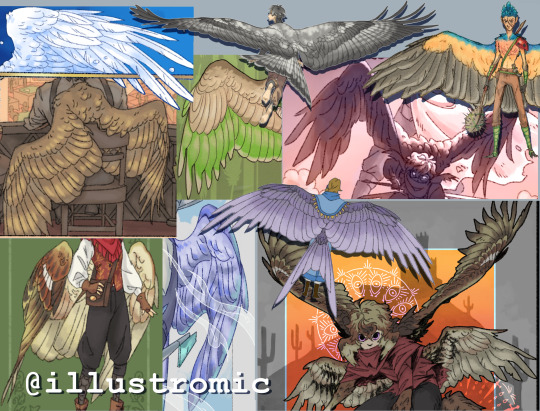
Like what you see? Read on! (Oh, and I will only be covering feathered/avian wings bc those are the type I know best.)
Now, I'm not here to give you a step-by-step guide on wing anatomy and aerodynamics, because there are plenty of other resources that cover this already, and I'll list my faves at the end of the post. Right now, I'm going to give you some easy guidelines and tricks that I wish more artists knew.
1: Wings do, in fact, have bones (crazy, I know) and are actually very rigid because they have to support the weight of a living creature. There are some positions you cannot physically force a wing into irl.
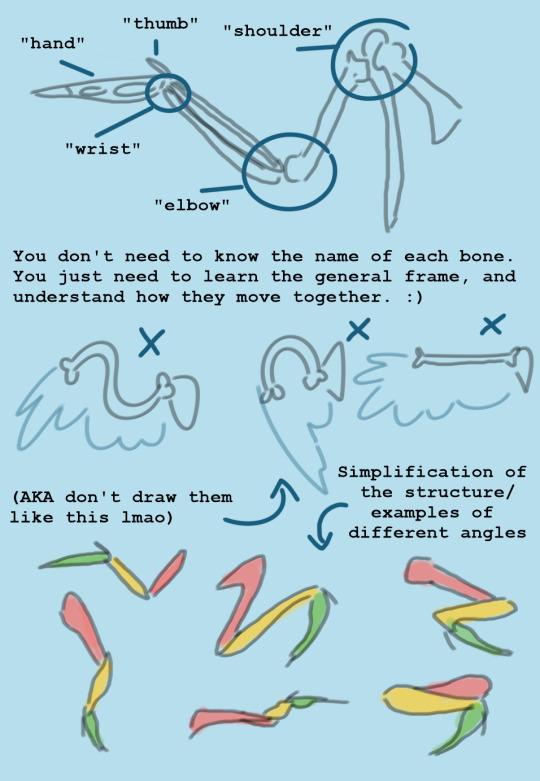
2: Flight feathers are not placed willy-nilly on the wing, because then they wouldn't catch the air properly. Again, like the bones, they are rigid and strong, so don't draw them like fur or ribbons. All wings have the same pattern of feather placement, with slight variation depending on species. If you learn the feather sections, it will automatically improve your drawings a lot.
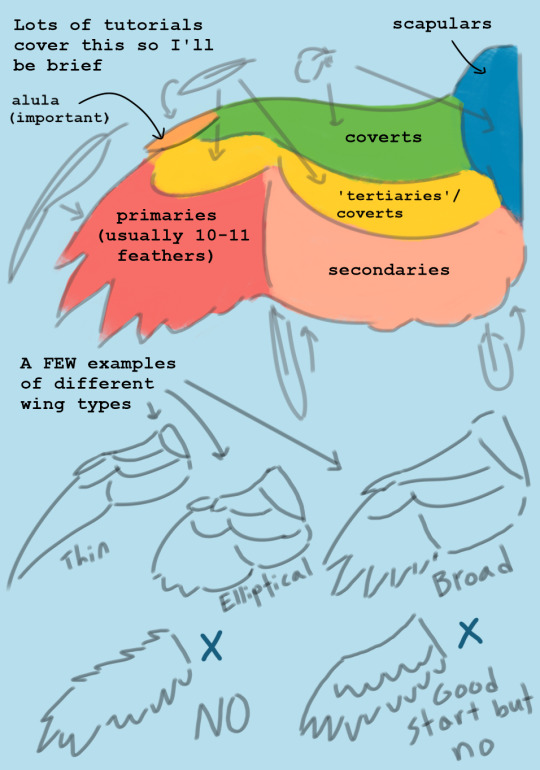
2.5: Feathers overlap each other like a handful of playing cards, and this looks different depending on which side of the wing you're drawing. They always do this unless they're extremely untidy.

3: The size of the wingspan is important if you're going for a more realistic design. There is no "scientifically accurate" measurement when it comes to fictional creatures, but my general rule is when in doubt, you probably need to make them bigger. Personally, for my original winged human species, I give them wings that can be up to 12 feet long each (the artistic sacrifice is that it's really hard to fit the wings on the dang page lmao, so make your own call).
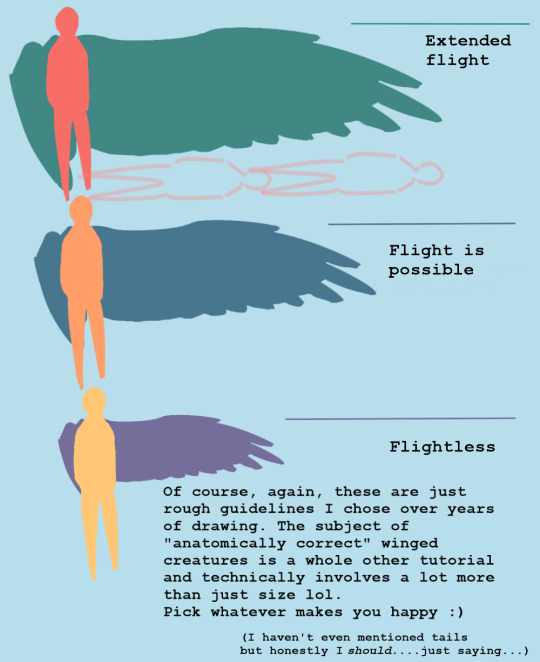
4: Get used to drawing folded wings. Most of the time, birds keep their wings folded because it prevents them from getting damaged and it conserves energy. The trick is to get good at visualizing how the joints bend and overlap (look at plenty of photos!) In general, they can fold much tighter than you think.

5: Wings and feathers take a lot of patience to draw, but the results are worth it. I've seen so so many incredibly beautiful and skillful artworks that are---well, maybe not ruined, but still negatively affected by a pair of wings that look like an afterthought, or not even like wings at all. You have no idea how much a little extra time and practice will add to your work until you see for yourself.
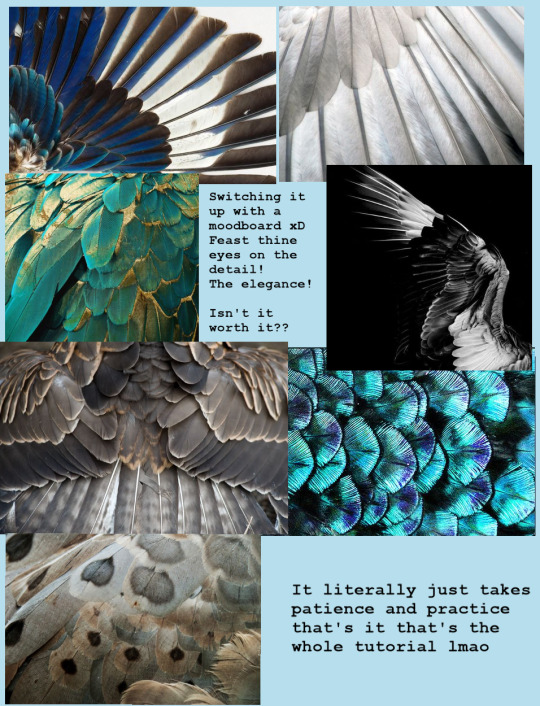
Finally, some notes on "stylized" wings: Of course it's perfectly ok to draw more simplified/cartoony wings if that's your preference!! BUT there is a difference between a stylistic choice and a lack of effort/poor understanding of the subject matter. Even cartoonists have to learn the fundamentals of realism so they know how to make their designs logical and appealing. Here are some examples of more stylized wings that I feel retain the core principles of anatomy/aesthetics:
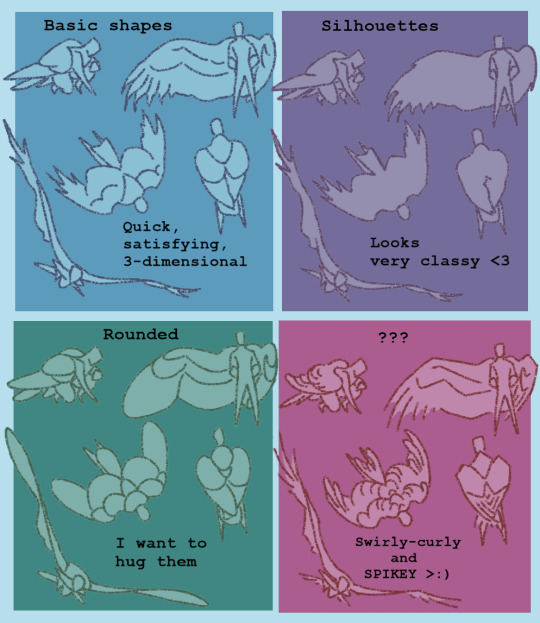
And last but not least: A list of helpful links I use personally for reference and inspiration!
I made this pinterest board for general artsy inspo, and this board to curate my very favorite tutorials/refs/information, focusing on the scientific aspect of wings and flight in general. Feel free to use both! (I also suggest pinterest in general for pose refs and such, but try to only practice using photos at first and not other drawings.)
I highly recommend this blog and this blog if you want examples of artists who draw more realism-based winged creatures!! They are both huge inspirations for me and I think you should totally follow them even if you don't plan to draw wings lol <3
If you're REALLY serious about it, my favorite ref books are: Winged Fantasy, a lovely drawing book by Brenda Lyons; Proctor & Lynch's Manual of Ornithology; and Angelus vincens by R. Spano, which is essentially an artbook by someone who (I believe) designed biologically plausible "angels" for their senior thesis.
Ok, idk how to end this lol but I hope it helped! I know it's not my normal kind of post but I'm super busy with college stuff rn and this was all I had time for. If you guys have any questions or feedback, please let me know!!!
-Aloe <3
#my art#wings#drawing#tutorial#the way I could've talked for so much longer haha#but it's 3 am for me and I am fading fast so GOODNIGHT
2K notes
·
View notes
Text
Bionicle's Bohrok were one of the first antagonists in the theme, yet it's incredible how their designs nailed their characterization and story role while being unique. Let's analyze them all, for they must be analyzed.
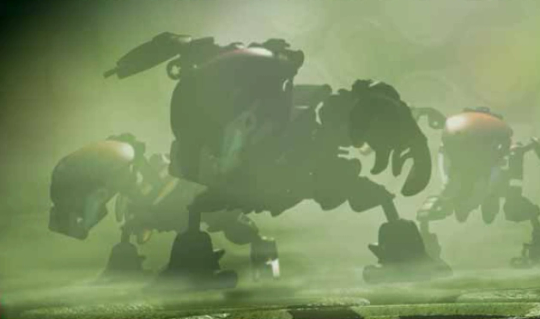
In my review of Friends' Leo, I stressed the importance of communicating character and story role efficiently and effectively in a toy, since you can't guarantee that everyone will read the supplementary material before or after buying it. This is also true for the Bohrok, but their story isn't about baking and soccer games.


The Bohrok are a hive of powerful, fearless and mysterious machines built long ago, kept in a deep slumber underground. When awoken, they swarm the surface and destroy everything, per their directive to "clean it all" (The Bohrok aren't truly evil, it's just that our heroes count as "all" right now). There's no use appealing to emotions or morals, since the Bohrok have neither. While the story's main protagonists can disarm a few Bohrok at a time, their weapons can't stop the whole swarm.
Aside from a few technicalities, this is a typical "alien invasion" story, so the Bohrok need designs befitting an invading force. They need to instill fear and look unfamiliar, but they should also have an interesting thematic throughline. On top of that, the Bohrok need to look distinct from other monsters in fiction and unmistakably belong to Bionicle. How did the designers solve these dilemmas?
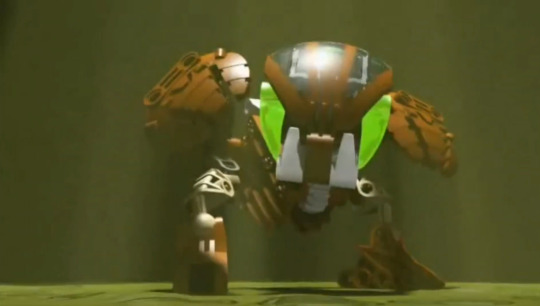
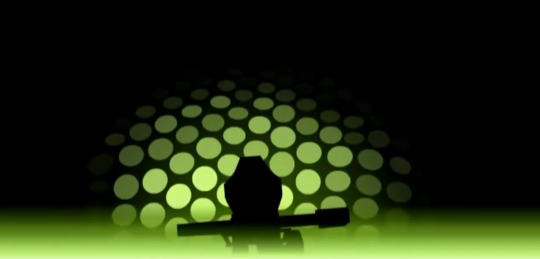
Like many sci-fi and horror creatures, the Bohrok's designs draw from a classic well of inspiration: the arthropods. Basing a design on something so different from humans is a convenient way to instill unfamiliarity and fear (it's partly why more people fear spiders than deer, who have a much higher body count). The Bohrok don't draw from a single creepy crawly, though: they have sturdy, compact bodies reminiscent of beetles, the cast structure of termites (two monarchs, a wealth of soldiers, and diminutive helpers), powers that evoke the roles of eusocial insects in an exaggerated way, a hive similar to a bee's, the ability to curl into a ball like a woodlouse, big eyes and sharp mandibles.

The Bohrok also deviate from their inspirations as much as they borrow: they're bipedal, they have two body segments, and they lack many of the trademark body parts of an arthropod, such as wings, antennae and stingers. Altogether, the Bohrok's designs are hard to pin down - they're not quite animals, but not humanlike either - and that ups their fear factor (their sharp shape language also helps). Their inscrutable faces sell their lack of individual thought and makes it even harder to relate to them.

This may not have been intentional, but one of my favorite details about this character design is how it plays with our tendency to look for eyes first. Since the standard Bohrok silhouette is bipedal, I was conditioned to find the Bohrok's eyes near the top of its head, but this failed me since I just saw their clear head-plates. Those teardrop-shaped parts next to the mandibles are their actual eyes. Even if this misdirect lasted for a few seconds, it left a distinct impression on me.
Nailing the fundamentals is all well and good, but I could have used those earlier paragraphs to describe a lot of monsters. What makes the Bohrok so special? The answers lie in what made Bionicle so special in its early years: the focus on combat and the masks.

You may have noticed that beneath the Bohrok's head-plates lie rubbery, face-like things: those are krana, the brains of the Bohrok and their only piece of organic tissue. This exposed brain serves as both ghastly imagery and a play function: press down on the Bohrok's eyes and the krana jumps out. If it finds its way on a character's head, they become part of the swarm.

Mind control and assimilation are two other classic sci-fi conventions, conveyed beautifully by the krana forcibly replacing the victim's mask, the window into their character. Combined with how they don't quite fit their victims' heads, you know something isn't right when a character is wearing one of these.
Since both the traditional masks and the krana are designed to be knocked off in battle and the Bohrok can attack using their gear functions, the intended story can unfold naturally through play. Children could easily invent stories where a Bohrok emerges and it's too powerful, and uh-oh, one of the heroes has become corrupted! They can pit heroes against heroes, or maybe the villagers find their own way to stop a Bohrok. Sure enough, these possibilities are explored in supplementary material.
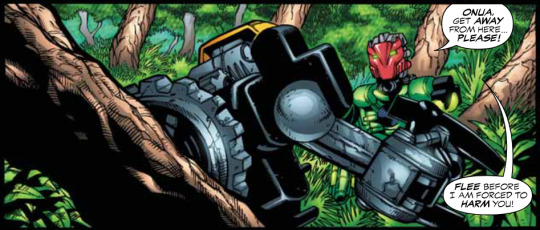
It's no easy feat to make a design's inspiration and role clear while also respecting its mystery, but the Bohrok stick the landing. While the tropes they pay homage to are familiar, they put a Bionicle spin on them. They truly earned their status as one of Bionicle's most iconic antagonists.
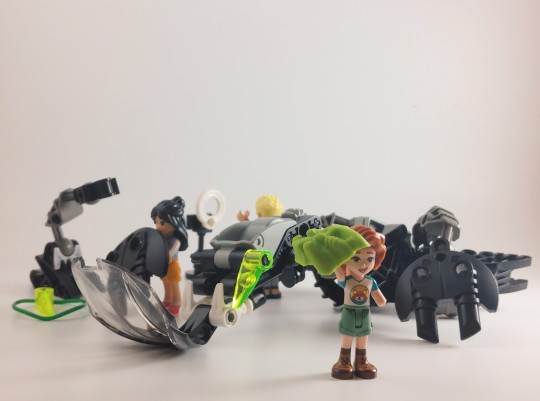
Author's note: Thanks for reading my second analysis! Going from minidolls to Technic creatures was a weird transition, but I'm glad I chose these bonkle bugs as my first non-minifig, non-minidoll subject. Brushing up on the lore was a ride.
I probably won't analyze another Bionicle character for a while, though, as I want to represent a wide variety of themes on this blog. Still, I appreciate recommendations and feedback.
If you're wondering about the Friends cast in that last picture: originally I planned to showcase the Bohrok's play features through a Nuhvok invading Heartlake City and destroying stuff, but I thought it would be more fitting to use its home series' media to prove my points. Plus, I forgot just how small typical LEGO characters were to the Bohrok. I still wanted to include something featuring them, so here's Autumn and pals dismantling it. Careful with that krana!
72 notes
·
View notes
Text
Malleus Facts Part 62: Malleus and Ortho
Malleus and Ortho meet by chance in the library when Malleus is looking for “something noble and refined” (besides dragons) upon which he can model Diasomnia’s Halloween costumes, and begins scouring each bookshelf of the school’s library one by one, as he does not know how to use the library computer to search for what he wants.



Malleus assembles a hundred books related to folklore, attracting Ortho’s attention. Ortho offers to help him with his search, first landing on the Chernabog, ruler of the monsters of Bald Mountain from Disney’s Fantasia.
Malleus vetoes the idea on the grounds that it will be too plain to please Lilia.
Ortho then recommends the headless horseman which Malleus turns down as “it would be too difficult to replicate the headless look” and due to all of the work that would be involved in finding enough horses for all the students of Diasomnia.



Ortho introduces Malleus to longs, which Malleus says strikes him as a noble entity “that embodies both strength and flexibility. And moreover, it is a creature (he has) never laid eyes on before.”
Malleus asks Ortho to teach him more about longs, and Ortho agrees. As Malleus predicted, Lilia enjoys the colorful designs.
When Lilia refers to longs as dragons Malleus corrects him, as “the long and the Western dragon are fundamental different creatures. Their appearances and powers differ in more ways than is initially apparent" which is presumably information from Ortho. Malleus says Ortho’s assistance was invaluable, even though he had no idea how he did what he did.


In Book 7 Ortho discovers that he is the perfect foil to Malleus as faeries manipulate the natural world, but he exists outside of nature.
Ortho is sent on a mission to infiltrate Malleus’ energy field—despite having only barely managed to escape it—and set up an analysis anchor to send data back to STYX.
His mother emphasizes that he is NOT to subdue Malleus. (And that is as far as EN has reached!)
Ortho has given Malleus electronics twice for his birthday—a shaved ice machine and VR goggles—neither of which Malleus understands how to use.
In his third birthday card he assumes Ortho is playing a prank on him.


88 notes
·
View notes
Text
youtube
So I don't usually get involved in class balance discourse but recently I stumbled across this video and it made me realize something about D&D's game design, specifically WHY casters get access to room/encounter clearing amounts of damage while martial characters are stuck with their low damage iterative attacks.
See, since d&d was one of the first things to emerge from the primordial soup of ttrpgs there were a lot of developments in game design that we take for granted today that simply didn't exist as concepts back then. One of these was asymetricality: the idea that different players at the table might be using their own set of mechanics to interact with the game at different levels.
Today we understand that while our DMs/GMs/Storytellers/Directors are fellow players, the game is FUNDAMENTALLY DIFFERENT from their perspective and the mechanics they have access to should probably reflect that.
I've complained before that d&d's monster making system is nigh unusable because it expects you to do a lot of extraneous work for a creature that's going to be dead in three rounds. This is because the game has traditionally modelled monsters in nearly the same way that it models player characters, which seems like the most backwards bit of game design ever until you remember that d&d evolved from wargames, where having a unified system with clearly defined math was important for maintaining competitive balance.
Magic is unbalanced for the same reason that monsters are over-complicated, because it expects the party and the dungeonmaster to be using the same mechanics despite their fundamentally different play experiences.
Think about it: however much fun it is to make things explode Fireball and it's big brother Meteor Swarm are not well designed player spells. They're really USEFUL for a DM looking to deal a lot of damage to a relevant level party, but encounter balance starts to go out the window once the players get their hands on them.
So how do we fix this? Honestly, not sure. I'm really interested in how the 5e successors are taking advantage of the asymmetrical nature of the GM/Player dynamic, as everyone's seemed to have independently learned the lesson that there should probably be a different set of mechanics depending on whether you're behind the screen or not.
For D&D itself though, I think it's one of those things that I'm going to need to tinker with for a while and up my game design skill. Learning where the game breaks down teaches us how to improve it. Currently I'm experimenting with retooling player HP and making counter-magic a LOT more common to make the use of those big encounter-ending spells more tactical. I might also take a look into it if I ever feel like tangling with the spell economy.
90 notes
·
View notes
Note
OMG I RECOGNIZED YOUR ART FROM FUNDAMENTALS OF CREATURE DESIGN, THAT BOOK IS SO COOL YOUR ART AND CREATURES ARE EPIC
Thank you, that book was a pleasure to work on :)
55 notes
·
View notes